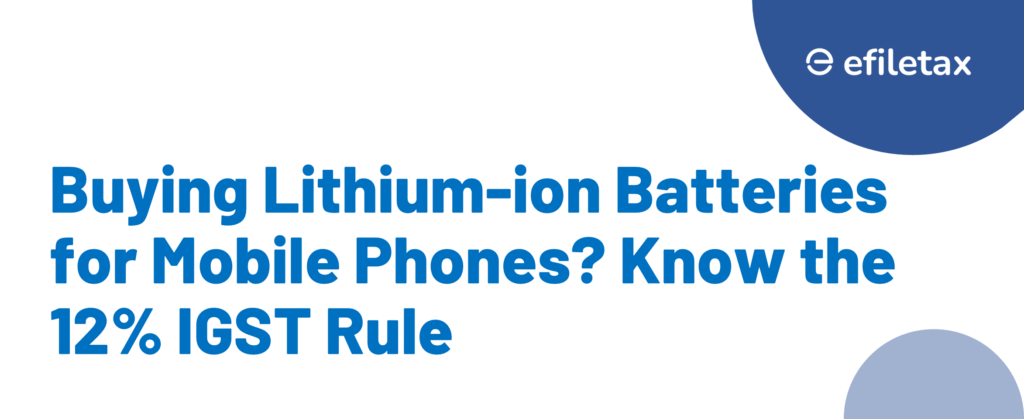
Lithium-ion Batteries for Manufacture of Mobile Phones Attract 12% IGST
Lithium-ion batteries used in mobile phone manufacturing attract 12% IGST, as clarified by the CBIC. This clarification resolves ambiguity around the applicable tax rate and aligns battery supplies with concessional GST benefits under specific conditions.
Let’s break it down for manufacturers, OEMs, and tax consultants.
What Did CBIC Clarify?
As per CBIC Circular No. 246/02/2025-GST dated 27.03.2025, IGST at 12% is applicable on lithium-ion batteries supplied to manufacturers of mobile phones, provided certain conditions are met.
This clarification addresses the confusion arising from the dual GST rates on batteries:
- 18% GST for general supplies (HSN 8507)
- 12% IGST for batteries supplied for use in mobile phone manufacturing (as inputs)
Legal Basis for 12% IGST Rate
✅ Notification No. 01/2017-Integrated Tax (Rate) dated 28.06.2017, Schedule I
✅ Entry 7, S. No. 450, inserted via Notification No. 19/2021-Integrated Tax (Rate)
✅ Clarified by Circular No. 246/02/2025-GST
Key Condition:
The supplier must declare that the lithium-ion batteries are intended for use in the manufacture of mobile phones.
When Does 12% IGST Apply?
| Scenario | IGST Rate | Remarks |
|---|---|---|
| Lithium-ion battery sold to mobile phone manufacturer | 12% | Must furnish use declaration |
| Lithium-ion battery sold in open market (no end-use specified) | 18% | Standard HSN rate |
| Battery sold to other industries (e.g., EVs, power banks) | 18% | No concessional rate |
How Should Manufacturers and Suppliers Comply?
To ensure 12% IGST rate is applicable:
- Supplier should obtain end-use declaration from the buyer (mobile phone OEM)
- Maintain proper invoice documentation indicating use in mobile manufacturing
- Align HSN and classification correctly (HSN 8507)
Expert Tip: Avoid Costly GST Mismatch
Many manufacturers miss out on the 12% IGST due to poor documentation or unclear end-use declarations. Always:
- Use contractual clauses stating end-use
- Get buyer’s declaration in writing
- Keep a sample format ready for recurring buyers
🔍 A mismatch in invoice and actual end-use may lead to tax demand at 18%.
Why This Matters for OEMs and Startups
- Lower IGST rate = lower input cost
- Helps in working capital efficiency
- Supports India’s Make in India and PLI Scheme goals in electronics
CBIC Circular Reference
🔗 Circular No. 246/02/2025-GST dated 27.03.2025 – cbic-gst.gov.in
Summary
CBIC clarifies that lithium-ion batteries used for manufacturing mobile phones attract only 12% IGST, not 18%. To avail the concessional rate, suppliers must declare the intended use. This move helps reduce input cost for OEMs under Make in India.
FAQs
Q1. Can the 12% IGST rate apply to batteries used in power banks or EVs?
No, the concessional rate applies only when batteries are used in the manufacture of mobile phones, as per CBIC.
Q2. Is it mandatory to get a declaration from the buyer?
Yes. Without proof of end-use, the battery will attract 18% IGST.
Q3. What is the HSN code for lithium-ion batteries?
HSN Code 8507 – used for classification under GST.
Final Thoughts
This clarification brings relief and clarity to the mobile phone manufacturing sector. By ensuring proper documentation and aligning GST invoicing, businesses can lawfully avail the 12% IGST benefit on lithium-ion batteries.